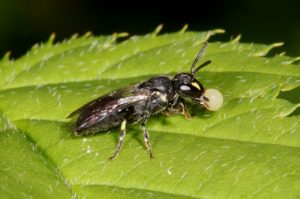Tiny yellow face bee delicately eats pollen from Echium anthers
This tiny solitary bee, like all bees, works hard. However, in this case, I believe it is a very labour intensive method to collect pollen and nectar.

Yellow-face bee blowing nectar bubbles to concentrate nectar
The bubble blowing bees
Nectar contains water. These bees blow out nectar bubbles and suck them back in again to evaporate the water, known as water homeostasis. This concentrates and thickens the nectar/pollen mixture making it tacky like honey. The concentrated liquid brood mass requires the larvae to ‘swim’ across it doing a kind of sidestroke, something that is unique to plasterer bees.
Once she has eaten the pollen and swallowed it, it goes into her crop, where she mixes it with nectar. Unlike other many other solitary bees, she regurgitates the nectar/pollen mix into an individual cell and then lays her egg on the vertical surface of the liquid wall. the resulting larvae eat the liquid nectar/pollen mix.
An extremely useful resource supports this book by a special website feature within Steve Falk’s Flickr website which furnishes extra photos and other useful resources to assist with identification.
see Solitary Bees book by Ted Benton
Interested in Citizen Science and pollinators? (e.g. bees!) The Buzz Club
More details to follow

These are remarkable, photographically documented observations for a tiny overlooked bee that we know too little about. You might think that we know everything there is about acquisition, transport and processing of pollen and nectar by this and the many other solitary bees, but it is not so. There are many surprises and insights like this one that are yet to be discovered. Bravo! jim
Thank you, Jim. I have a lot more than that shown. Wait till you see my Gasteruption jaculator ovipositing film!